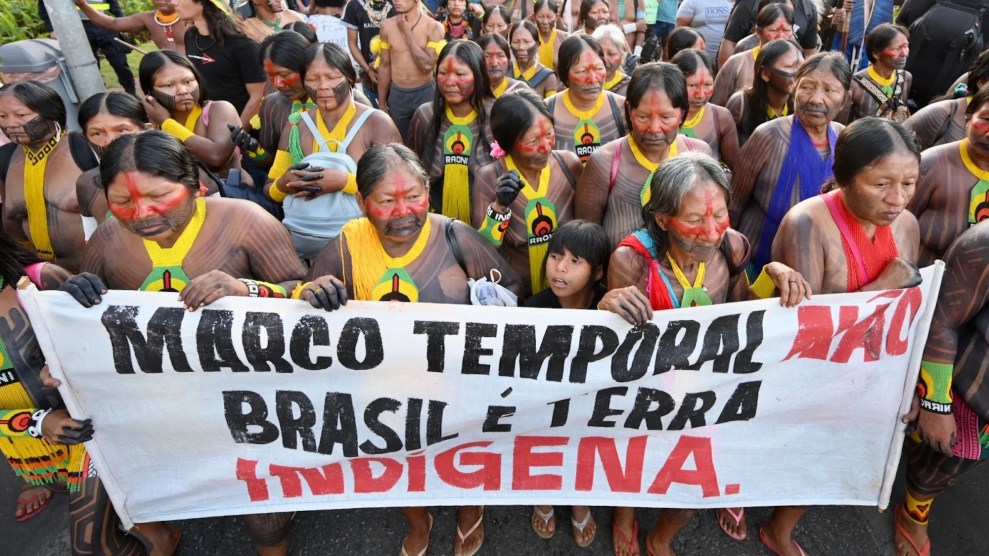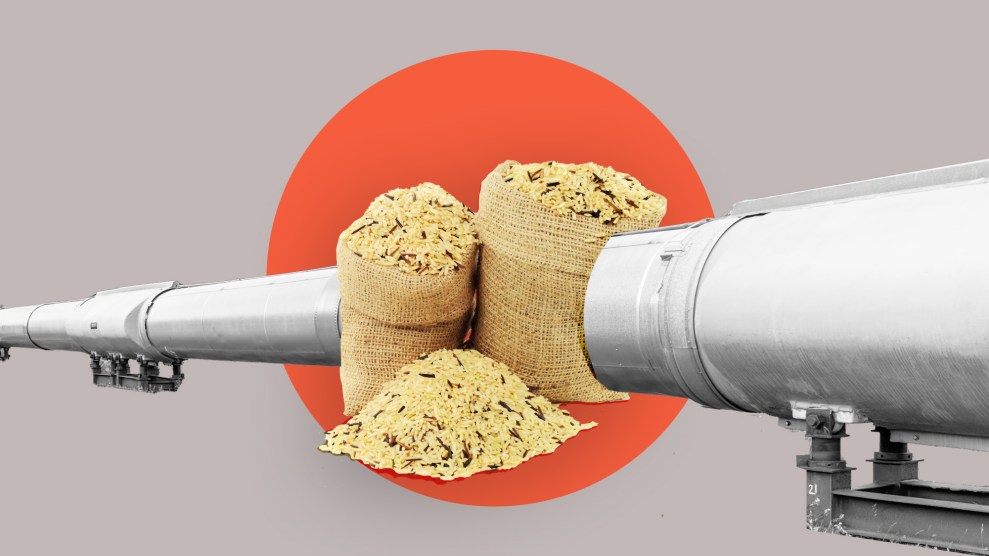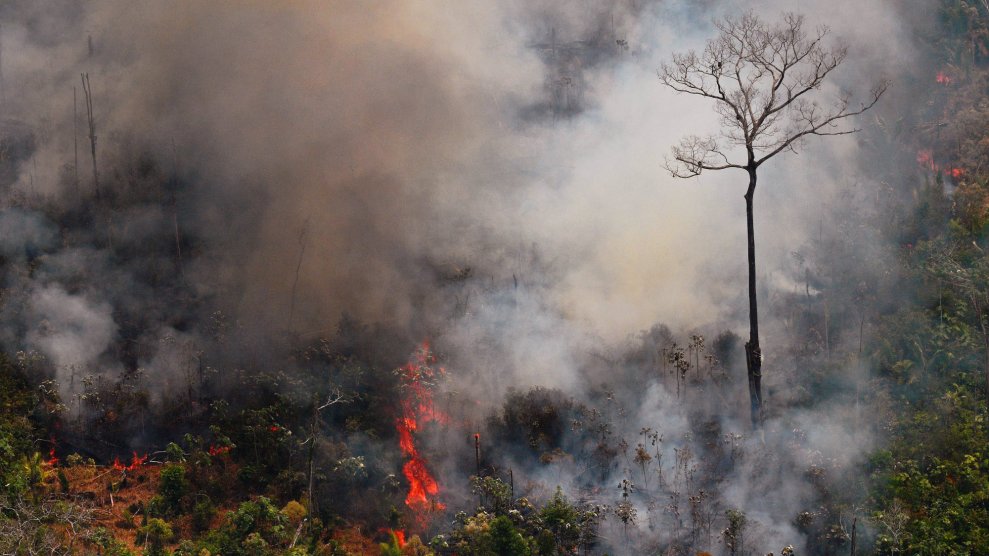
Indigenous protesters decry "marco temporal," the legal theory that could wreak havoc on their land rights.EVARISTO SA/AFP via Getty Images/Grist
This story was originally published by Grist and is reproduced here as part of the Climate Desk collaboration.
At the end of May, Brazilian lawmakers approved legislation that would invalidate Indigenous land claims and open protected Indigenous lands to mining, road-building, agriculture, and other extractive industries.
The legislation was overwhelmingly endorsed in the nation’s conservative-dominated lower house and has now progressed to the Senate for approval.
But the bill is moving slowly. That’s because a central piece of the legislation is already being examined in Brazil’s Supreme Court. The legal thesis under examination, marco temporal, has been moving through the courts since 2007 and, depending on the court’s interpretation, could determine the future of Indigenous land in the Brazilian Amazon that has yet to be recognized by the Brazilian government. The ruling would also have major impacts on the constitutionality of the legislation.
“If the ‘marco temporal’ thesis is approved, all Indigenous lands, regardless of their status and region, will be evaluated according to the thesis, putting all 1393 Indigenous Lands under direct threat,” said United Nations Special Rapporteur on the rights of Indigenous Peoples, José Francisco Calí Tzay in a statement.
But what is marco temporal?
Brazil’s constitution gives Indigenous people the right to claim lands they “traditionally occupied,” and since the adoption of the constitution in 1988, more than 700 Indigenous territories have been claimed. To date, 496 have been officially recognized, or demarcated, by the government, which defines property boundaries and guarantees the possession of the land and the exclusive use of its natural resources to the Indigenous peoples who live on it.
First introduced in 2007, marco temporal, is the idea that if Indigenous communities weren’t on the land they claimed in 1988, when the constitution was passed, they have no claim to those lands.
For most of Brazil’s history, land occupied by Indigenous peoples was technically owned by the government. The Indian Statute of 1973, contains rules on the relations of the state and Brazilian society with the indigenous communities, and gave Indigenous people the same legal status as children, meaning they didn’t have standing to represent themselves in the state’s legal system—including in land matters.
“At the time, the idea behind the legislation was that Indigenous peoples had to be emancipated from their condition as Indigenous peoples in order to be fully, standing Brazilians citizens,” said Tracy Divine, associate professor of Latin American Studies at the University of Miami and research fellow for the Washington Brazil Office. “It wasn’t until the 1988 constitution that the state decided that people in Brazil could be indigenous and Brazilian at the same time.”
This means even if Indigenous peoples were occupying traditional lands before 1988, they weren’t allowed to register their land ownership with the Brazilian government which renders their arguments in court as unprovable.
If accepted, the legal thesis of marco temporal would empower Congress to accept, or reject, Indigenous land claims, instead of the president, making the protection of Indigenous territories more difficult, and create opportunities to change currently accepted territorial boundaries.
“It goes against the constitution of the country because the constitution of the country uses the term ‘original rights to land’,” said Divine. “But what the constitution says is that Indigenous peoples have original rights to the land, which would mean that their rights pre-date even the formation of Brazil as a country.”
Marco temporal has its origins in agribusiness and has been adopted and pushed by a variety of developers, loggers, miners, and farmers with business interests in the Amazon—areas that may already be protected due to the Indigenous communities that manage their territories or could be protected in the future.
Many marco temporal proponents cite economic development as a key reason to codify the idea, especially for soybean production, cattle farming, and mining. Lobbyists for those industries have been quite vocal in their support.
Indigenous peoples, however, argue that the lands in question have been theirs since time immemorial regardless of their history with the government, that the constitution backs their claims, and that further development in the Amazon would be detrimental to their health, and that of the rainforest.
It’s estimated that Indigenous peoples safeguard nearly 80 percent of the planet’s remaining biodiversity with the Brazilian rainforest containing almost a quarter of all terrestrial biodiversity and 10 percent of all known species on earth.
Over the last four years, deforestation in the Amazon rose 56 percent with an estimated 13,000 square miles of land destroyed by development. During that time, Indigenous peoples lost an estimated 965 square miles of their traditional territories under former president Jair Bolsonaro’s policies.
Since legislators in the lower house passed the controversial legislation, protests have taken place in Brasilia, the nation’s capital and Indigenous groups have blocked roads outside of Sao Paulo, Brazil’s largest city, burning tires and using bows and arrows against police who responded with tear gas.
At this point, Indigenous peoples in Brazil await the court’s decisions as well as congress’s actions, and while President Luiz Inácio Lula da Silva could ultimately veto the bill, there is fear he could approve legislation that adheres to marco temporal to satisfy the agro industry which constitutes a bulk of the country’s economic survival. Brazil ranks among the top 12 largest economies in the world with their gross domestic product (GDP) estimated at US$1.65 trillion in 2021. The country supplies more than 50 percent of the world’s soybean trade from crops produced on 17 percent of the country’s arable land.
“We knew the right would have a reaction against any pro-indigenous and pro-environment measures taken by Lula,” said Ana Carolina Alfinito, a legal adviser on Brazilian affairs for Amazon Watch. “What we didn’t expect is that this action would be so fast and so intense.”














